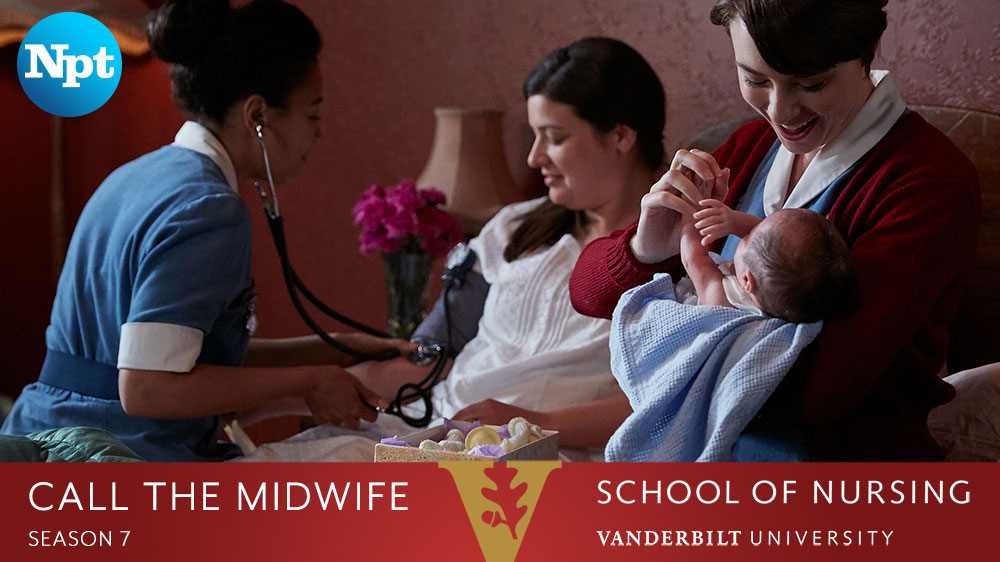By Michelle Collins
Vanderbilt University School of Nursing
Call the Midwife is back for a seventh season and so are the faculty of the Vanderbilt University School of Nursing with a weekly guest blog. Watch the show Sundays at 7 p.m. through May 6, then read our blog each Monday morning for historical and contemporary context about the previous night’s episode. SPOILER ALERT: Some posts may contain spoilers.
The seventh season of Call the Midwife began Sunday with a double-header. In addition to the snowbound arrival of Midwife Lucille Anderson (played by Leonie Elliott), the first episode of the night explored several compelling situations.
 Many viewers may have been enthralled by the realistic portrayal of a breech (buttocks first) birth in the series. Approximately 3 percent of babies at term are breech. While the mechanisms Midwife Trixie Franklin (played by Helen George) employed at the birth may have seemed unorthodox (letting the baby’s body hang unsupported from the mother’s vagina while waiting for the head to be born), she was using exactly the correct childbirth maneuvers for a breech delivery.
Many viewers may have been enthralled by the realistic portrayal of a breech (buttocks first) birth in the series. Approximately 3 percent of babies at term are breech. While the mechanisms Midwife Trixie Franklin (played by Helen George) employed at the birth may have seemed unorthodox (letting the baby’s body hang unsupported from the mother’s vagina while waiting for the head to be born), she was using exactly the correct childbirth maneuvers for a breech delivery.
Viewers also saw Trixie suction the baby’s mouth with flexible tubing that had one end inserted into the baby’s mouth and the other into her own. This type of suction has a small trap between the two tubings wherein the mucous from the baby is (with hope) deposited by the manual suction provided by the birth attendant. Believe it or not, a version of this type of device was used until not all that long ago and may still be in use in some places.
Aside from the breech presentation, Trixie’s patient had an issue with Rh incompatibility. What this means is that the mother had a blood type with a negative Rh, O negative for example, while her baby had a blood type with a positive Rh. If the mother’s body creates antibodies against the fetal blood cells during her first pregnancy, her subsequent babies may be affected if they are Rh positive. Babies affected by Rh incompatibility can develop severe jaundice which can lead to brain damage. Sometimes a blood transfusion may be required, as was the case in this episode. Rh incompatibility can also cause recurrent pregnancy loss. In the late 1960s, Rho(D) immune globulin ‒ a medication used to prevent Rh incompatibility ‒ began to be manufactured and is now recommended to pregnant women who are Rh negative.
Finally, viewers new to Call the Midwife may be confused as to why Midwife Phyllis Crane (played by Linda Bassett) was caring for an elderly woman with a terminal illness. Midwives in the U.K. (as in the U.S.) were originally public health nurses whose scope of practice included primary nursing duties. Even today, certified nurse-midwives are educated as nurses first, midwives second. Our background in nursing is invaluable to our work as midwives; we draw upon that knowledge frequently. We are also primary care providers, which means we attend to our patients’ basic health care needs, be that obstetric, gynecologic or otherwise.
It was interesting to see nitrous oxide used to relieve pain in childbirth as well as for the terminally ill woman. If you think about it, there are many similarities between the processes of birth and death, thus midwives may be the perfect providers to attending both. We all deserve “midwifing” both in entering, and leaving, this life. Indeed as the voice-over by Vanessa Redgrave (as Midwife Jenny Lee) noted: “Waiting for a passing is like waiting for a birth; we need things to keep us occupied.”
Michelle Collins Ph.D., CNM, FACNM, FAAN is a Professor of Nursing and Director of the Nurse-Midwifery Program, at Vanderbilt University School of Nursing.

1 Comment
All very well acted